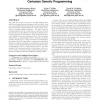Free Online Productivity Tools
i2Speak
i2Symbol
i2OCR
iTex2Img
iWeb2Print
iWeb2Shot
i2Type
iPdf2Split
iPdf2Merge
i2Bopomofo
i2Arabic
i2Style
i2Image
i2PDF
iLatex2Rtf
Sci2ools
GECCO
2007
Springer
2007
Springer
A developmental model of neural computation using cartesian genetic programming
The brain has long been seen as a powerful analogy from which novel computational techniques could be devised. However, most artificial neural network approaches have ignored the genetic basis of neural functions. In this paper we describe a radically different approach. We have devised a compartmental model of a neuron as a collection of seven chromosomes encoding distinct computational functions representing aspects of real neurons. This model allows neurons, dendrites, and axon branches to grow, die and change while solving a computational problem. This also causes the synaptic morphology to change and affect the information processing. Since the appropriate computational equivalent functions of neural computation are unknown, we have used a form of genetic programming known as Cartesian Genetic Programming (CGP) to obtain these functions. We have evaluated the learning potential of this system in the context of solving a well known agent based learning scenario, known as wumpus...
| Added | 07 Jun 2010 |
| Updated | 07 Jun 2010 |
| Type | Conference |
| Year | 2007 |
| Where | GECCO |
| Authors | Gul Muhammad Khan, Julian F. Miller, David M. Halliday |
Comments (0)

